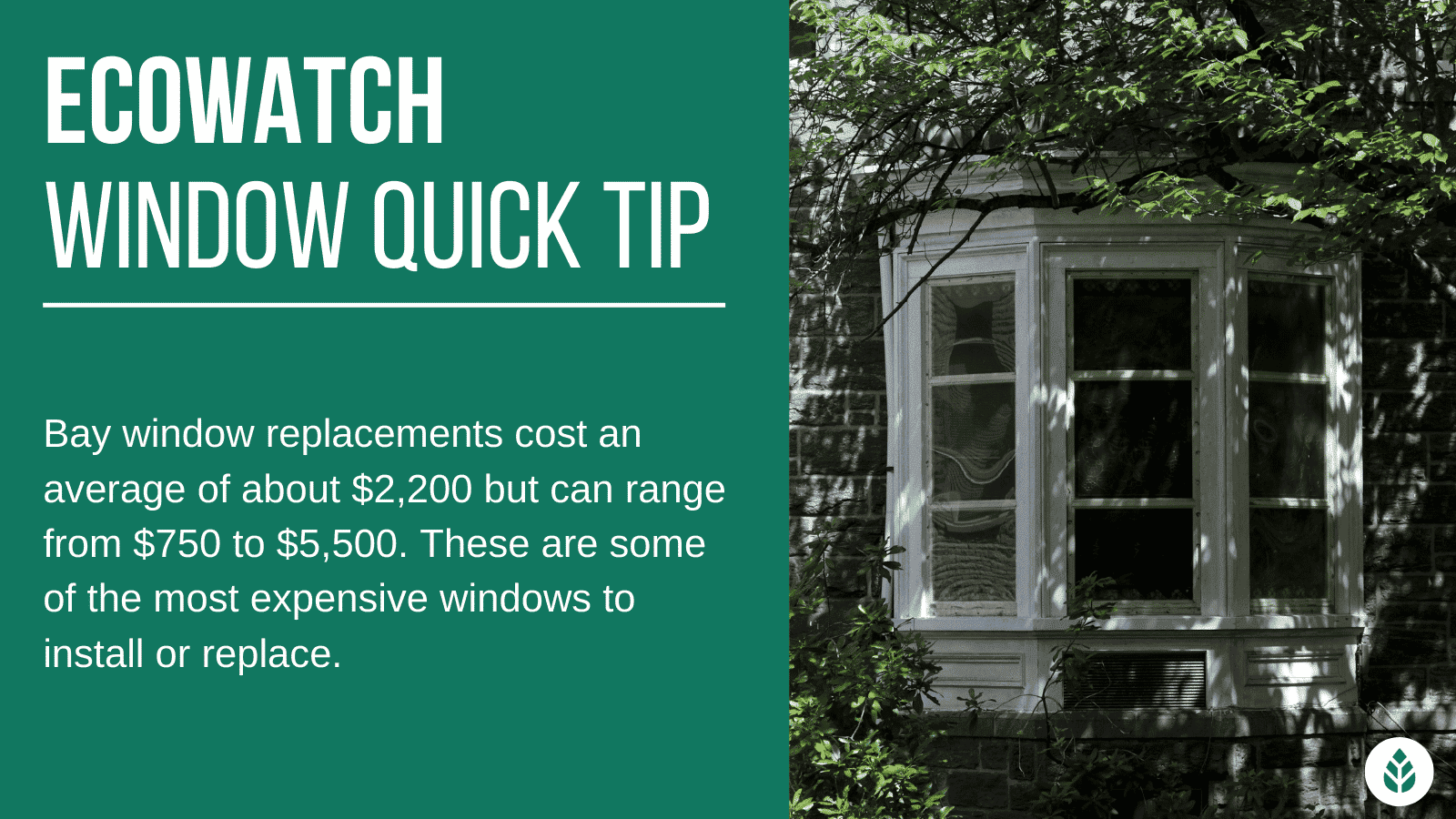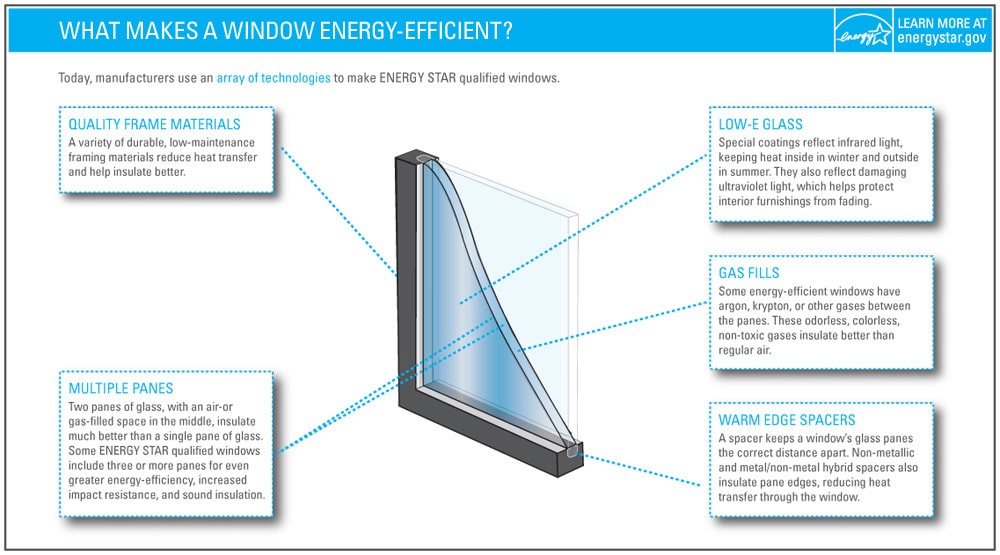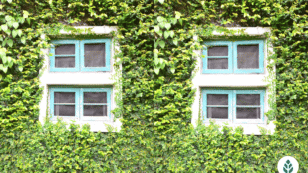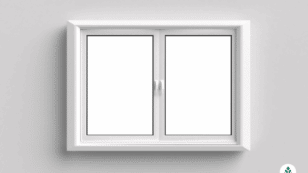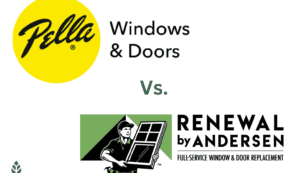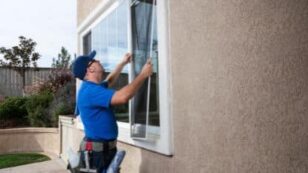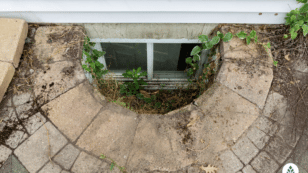

Window Replacement Cost 2024 (Homeowner’s Guide)
In this guide on the cost of window replacement, you’ll learn:
- What does it cost to replace or repair a window?
- How different types of windows and energy efficiency can affect pricing?
- How do you know it’s time to replace windows?
This EcoWatch guide has helped many homeowners estimate window replacement cost and has allowed them to find the best resources for the job. Enter your zip code below to receive a personalized quote on window repair companies near you.
Each product and or company featured here has been independently selected by the writer. You can learn more about our review methodology here. If you make a purchase using the links included, we may earn commission.
How Much Does Window Replacement Cost?
The average cost to replace a single home window in the US will run you around $600. There’s many factors that go into that price, and prices can vary depending on the contractor you choose to use, the type of window you go with, and sometimes even where you are geographically located. Replacing a window might seem like a massive undertaking, but leaving the work to professionals makes the process a whole lot easier and faster.
Replacing your old windows with new, energy-efficient windows is also one of the most eco-friendly upgrades you can make for your home. Energy Star-certified windows can significantly reduce the amount of electricity your household consumes by minimizing the amount of hot or cool air that escapes from your home. It’s a win-win for your wallet and the planet. It may be hard to know what windows are best for you, but don’t fret.
Don’t fret, we’ve done the research and will be discussing the cost of window replacement, the factors that can affect your total price, how to know it’s time to replace windows and more.
7 Steps to Calculate Your Window Replacement Estimate
As you can see from the estimates above, the price of replacing a window can vary wildly. The reason for the wide range of possible prices is because there are quite a few factors to consider that can affect your replacement costs.
To calculate your estimate you should take into consideration the following components:
- Step 1: Pick your frame material
- The price of the frame material will vary costs. Frame materials also affect energy efficiency, the appearance of your window, the durability, and whether or not the windows are paintable for later updates. Different varying factor go into selecting the right frame type and frames differ by costs.
- Step 2: Pick the style of your window
- Which is the most significant cost factor in many cases. The type of window also affects the curb appeal, how much ventilation it provides, how much sunlight it lets in and the window’s functionality.
- Step 3: Choosing if you want an energy efficient window or not
- Energy efficient windows are often times more expensive to purchase upfront because of money saving potential in the long run
- Step 4: Select the glass type, quality, and pane count
- Similar to the above, sturdier glass types often end up being more expensive but can provide you with additional wins like better insulation, sound proofing, and storm related protection. Whether you choose a single, double or triple-pane window can affect your windows insulative properties
- Step 5: Identify the size of your window
- Whether you choose a standard window size or a custom window size can affect you overall prices. Also the size of the window (whether lager or smaller should be taken into consideration as well)
- Step 6: Identify where on your home your window is located
- The harder the location is to have your window installed, the more the price of installation will be due to riskier location. Understand that price may vary for a hard to reach area
- Step 7: Select a window replacement company with favorable pricing
- Don’t count out the possibility of a good deal when comparing window installers. Some local contractors can beat out national provider pricing and vice versa. Do you research and connect with a installer in your area

Renewal by Andersen

Save $375 Off Each Window
Average cost
Pros
- Great industry reputation
- Award-winning company
- Member of US Green Building Council
- Manufactures products in-house
Cons
- No lifetime warranty
- More expensive than competition

Window World

200 Locations Nationwide
Average cost
Pros
- EnergyStar Partner
- Large service area
- Wide variety of products and services
- Great industry reputation
- Lifetime warranty
Cons
- Quality of service will depend on your area

Window Nation

9 States (75 miles from showrooms)
Average cost
Pros
- Award-winning company
- Wide variety of products and services
- Manufactures products in-house
- Custom Designs
Cons
- Installation not covered by warranty
- Limited service area
Window Replacement Costs by Frame Material
One major cost factor many homeowners fail to consider is the frame material that surrounds the glass pane and allows for the installation in your wall. Windows come in several frame material options, each offering different degrees of convenience, durability, curb appeal and energy efficiency. With choice comes different pricing which will affect your overall costs when you consider how much a window replacement will run you.
Window Frame Style |
Avg Cost To Replace |
| Wooden Windows | $650 |
| Aluminum Windows | $400 |
| Vinyl Windows | $500 |
| Composite Windows | $800 |
| Fiberglass Windows | $1,000 |
Wood window frames will run you $650
Wood-frame windows are relatively expensive, averaging around $650 per window. Homeowners choose them because of their classic and timeless look. Wood is one of the most popular frame materials because of its curb appeal, which can be easily customized using exterior paint.
In addition to their desirable appearance, wood window frames don’t expand and contract with temperature changes, so they’re relatively durable and resist sticking in most cases. However, they can crack, chip, and warp with changes in humidity, so there are downsides to wood frames too. Wood is about average when it comes to energy efficiency.
Aluminum window frames are the most affordable
Aluminum-frame windows are slightly less expensive than vinyl, usually costing around $400 per window. Aluminum windows are lightweight and easy to transport and install. They require minimal maintenance and can be painted, although they do tend to have a shorter lifespan than other window frame materials.
Aluminum is the worst window frame material in terms of energy efficiency because metal conducts heat easily. However, aluminum windows won’t bend or warp in response to changes in temperature or humidity.
Vinyl window frames are a good mid-tier price option
Vinyl windows average $500 per window, and vinyl is one of the most popular frame materials. It provides a more modern appearance than wood, which some homeowners don’t like, and they can’t be painted, so you’re stuck with the color for as long as you have the window installed.
Vinyl is relatively durable and resists warping and bowing in response to heat and moisture. Vinyl windows aren’t quite as durable as wood or aluminum, but their affordability makes them the most popular type of window. Vinyl is a good insulator, and vinyl frames have cavities that you can fill with foam insulation. This option makes vinyl one of the most energy-efficient window frame materials.
Composite frames will be around $800
Composite window frames are made of a combination of materials, often including wood fibers for a classic appearance. They are more expensive than most other types, with an average per-window price of around $800.
Composite frames are very durable and offer great energy efficiency. Like vinyl, composite frames often have voids that you can fill with foam insulation for maximum insulative properties. Composite material resists warping, bowing and cracking.
Fiberglass window frames cost the most
Fiberglass-frame windows are the most expensive, averaging around $1,000 per new window. Fiberglass is high-end and extremely durable, so the price is worth the investment for many homeowners. Fiberglass can be made to look like wood or other materials, so they have some of the best curb appeal as well.
Fiberglass is a great insulator, so fiberglass window frames will provide the most efficiency for your home. These frames also typically have voids that you can fill with insulation for maximum protection from the hot or cold exterior air. The primary drawback to fiberglass window frames is the cost.
Window Replacement Prices by Style Type
Aside from having to take into consideration how many windows you’ll be replacing, the style and measurements of window replacements can have a significant impact on your replacement cost estimate as well. Some window styles are double or triple the cost of others, and larger windows will always cost more for materials. Below, we’ll discuss the average cost to replace some common window styles.
Window Type |
Avg Cost To Replace |
| Single Hung | $300 |
| Double Hung | $450 |
| Picture | $850 |
| Bay and Bow | $2,200 |
| Casement | $725 |
| Glass Block | $750 |
| Sliding | $500 |
| Skylight | $1,000 |
| Storm Windows | $150 |
Single-Hung
A single-hung window has two panes, one above the other. The bottom pane is in a movable sash to provide ventilation. Single-hung windows are one of the most affordable types of windows that open and close. You can expect to pay around $300 for the material and labor to replace a single-hung window, or between $100 and $450 depending on other factors.
Double-Hung
Double-hung windows also have two panes, but unlike single-hung windows both panes move to provide ventilation. In many cases, double-hung windows also tilt outward to allow for easy cleaning. Replacing a double-hung window will typically fall between $200 and $650 to replace, with an average of around $450.
Picture
A picture window is one that doesn’t open or close and instead serves to bring natural light into your living space. Replacing a picture window averages around $350 to install, but you could pay anywhere from $100 up to around $850, depending on the size and other factors.
Bay and Bow
Bay windows have three faces: two that extend out of your exterior wall at an angle and one in the middle that runs parallel to your exterior wall. Bay windows average around $2,200 but can range from $750 to $5,500. Bow windows protrude similarly from your exterior wall but have quite a few faces to give a curved appearance. Bow window replacement ranges from $1,000 up to $7,500, with an average cost of around $5,000.
Casement
A casement window is hinged on the side and opens using a crank or other manual mechanism. Casement windows can be found as standalone window options or as a part of bay windows. Some casement windows are hinged on the top and open outward using a mechanism, but these are more commonly referred to as awning windows. You can expect to pay around $725 to replace a single casement window, or anywhere from $200 to $1,000, depending on other factors.
Glass Block
As the name suggests, glass block windows are solid blocks of glass that come together to form a single window. These windows cannot open and close and are mostly for aesthetic purposes, although they also provide some natural light in your living space. A glass block window often totals around $750 to replace, but yours might cost anywhere between $400 and $1,200.
Sliding
A sliding window has one or more sashes that slide horizontally in the frame to allow for ventilation. Sliding windows cost $500 on average to replace. Most homeowners pay between $200 and $700 to replace a single sliding window.
Skylight
A skylight is a window set into your roof. Some skylights open, and others are like picture windows in your ceiling. Skylights add tons of natural sunlight to your living space, but they also are the most likely style to leak. Skylights are a bit more expensive than standard windows because they are among the most challenging to install, so they average around $1,000 to replace. You could pay anywhere between $800 and $2,200 for your skylight replacement.
Storm windows
Storm windows are installed over your existing windows to protect your interior from drafts and protect your regular windows from extreme weather. Storm windows are among the most affordable window styles to install, with prices falling between $100 and $450 and averaging around $150.
Window Replacement Prices for Energy Efficient Options
With more and more homeowners becoming environmentally conscious and local governments and utility companies incentivizing energy efficiency, energy-efficient windows are becoming more popular. There are a few things that affect a window’s energy efficiency and insulative value.
First, the frame material and the glass type can mean the difference between drafty windows and maximum energy efficiency. Fiberglass, composite and vinyl frames are all good insulators, but fiberglass and composite can also drive up your costs. Similarly, double-pane windows and triple-pane windows are more energy-efficient than single-pane options, but they are far more expensive per window to install. Still, they could end up saving you money on heating and cooling costs in the long run.
The style of window you’re replacing can also affect your home’s energy efficiency. Window styles that don’t open will always provide a better seal to the outside and be more efficient. Glass block windows are the most efficient because of the thickness of the glass. As far as opening windows go, casement windows have the best seal and provide the best chance for energy efficiency.
Energy-Efficient Window Treatments
There are quite a few different glazing options available to customize how efficient your windows are, but you can also get energy-efficient window treatments to improve the efficiency and UV-blocking capability. Specifically, a low-e coating (low-emissivity) can provide better insulation and protection from the sun. Of course, this added treatment will also bump up your cost per window, often by around $40 to $100 per window.
Some homeowners opt for tints on their windows, which blocks more sun than untinted windows and helps to reduce your cooling costs in the summer. However, tints won’t help with reducing heating costs in the winter, as tinting doesn’t affect heat transfer through your glass. You can expect to pay around $600 on average to tint all of your windows.
Other Window Replacement Cost Factors
While the style of the window you’re replacing is one of the most significant cost factors, there are quite a few other things you should consider that can have an impact on your price. We’ll discuss some additional window replacement cost factors below.
Glass Type and Size
When it comes to window size, larger windows of the same style and glass type will always be less energy-efficient, as glass isn’t as good an insulator as your exterior wall and insulation would be. The glass type plays a huge role.
Single-pane glass is the cheapest at between $100 and $300 per window, on average, but it’s also the least energy efficient. Double-pane glass has two glass panes with an insulative layer of argon or krypton gas between them. These double-pane windows cost between $300 and $900 each, on average. Triple-pane glass windows are made the same way but have three panes of glass and two layers of gas for the highest energy efficiency available. These triple-pane windows cost between $550 and $1,200 in most cases.
Here’s a quick video to help you understand which window you might need:
Window Location
The location of your window can play a fairly significant role in your window replacement cost. Windows on the first floor of your home are generally the easiest to install, as they don’t require special equipment or more than one or two installation technicians. These average around $500 to $600.
Windows on the second floor of your home require more laborers and sometimes special lifts to get the window into place, often totaling between $600 and $800 to replace. Skylights offer a unique challenge and require special safety and installation equipment, so they total between $800 and $2,200 for replacement.
Number of Glass Panes
Windows can come with just a single pane — like in some picture windows — or dozens of panes — like you might see in a bow window. The more panes your window has, the more costly it will be. It’s important to note that many modern windows have a single pane with dividers that create the appearance of multiple panes. This style will not drive up your cost.
House Age & Location
Older homes are more likely to have non-standard window sizes, which means you could spend much more on a single window than the national average if you have to order a custom window.
Additionally, your window replacement technician is more likely to uncover damage that needs to be dealt with in older homes, like water damage or termite damage. This can drive up your replacement costs significantly. Your location also matters, as more expensive areas to live tend to mean higher replacement costs, and your climate might require a specific window frame material that is less prone to heat, cold or humidity and ends up being more expensive.
Structural Repair Costs
In extreme cases, your window tech might uncover some structural issues or insufficiencies that need to be addressed before you can replace your window. This is most often an issue in older homes.
Windows are an easy place to spot structural problems because issues with your home’s foundation or stability will cause wall openings to shift, which can damage windows. You could be looking at hundreds or even thousands of dollars in structural repairs tacked on to your window replacement price in some cases, although this is relatively uncommon.
Insulation
Many homeowners make the mistake of assuming that the cost of the window is the total materials cost for replacement. Some window replacement jobs also need insulation and weatherstripping to be replaced as well, which can add between $100 and $200 in materials to your replacement costs.
Labor Costs
Finally, the labor costs you pay to have your window installed can cause your price to land well above or below the national average. Some installation companies charge far more than others for similar work but expect to pay an hourly rate of anywhere from $35 to $40. Although a more costly installer tends to provide a smoother installation and a warranty for the work completed and do take complexity of installation into account.
Additionally, some window installation companies only use high-end window brands, like Pella, Marvin and Andersen. These companies will naturally have a higher project cost, but it’s often worth the investment.
In order to have a better understanding of how much it will cost you to replace your window, we recommend consulting with a professional contractor to get a better estimate or quote for your own individual needs. Understanding how much and what goes into the quote will allow you to come better prepared to the conversation.
10 Signs You Should Replace Your Windows
Windows go through a lot of wear and tear from the outside environment, and they can get damaged by house settling and structural issues as well. There are quite a few signs you can look for that signal it’s time to replace your windows especially if utility bills are getting affected, including:
- Poorly Operating Windows: Windows that are challenging to open or close are likely suffering from swelling or shifting of the frame or sashes. While this can simply be a nuisance, it can also be a sign that your window seal is damaged and is no longer providing the same protection from the outside air.
- Visible Damage: If you can see damage to your window glass or window frame, it’s time to replace the window. You can look for cracks or chips in the glass or cracking, peeling, warping or chipping in the window frame material.
- High Home Energy Bills: Windows need to provide some insulation from the exterior air. If the glass or the frame fails to create a proper seal from the outside and lets cold air in in the winter or out in the summer, your energy bills might unexpectedly increase. If they do, it might be time to replace or upgrade your windows and enjoy some energy savings.
- Poor Noise Insulation: As windows lose their insulative properties, they also lose their ability to block out noise from the outside. If you start realizing that noises from traffic or passersby are more audible than usual from inside your house, it might be time to replace your windows.
- Leaky Windows: If you ever find water leaking in from around your window — usually toward the bottom — you should hire a professional to replace it immediately. Water intrusion can be a severe issue that should be handled right away.
- Drafty Windows: If you stand by your closed window in the winter and can feel cold air coming in from the outside, it’s a clear sign that you need to replace your windows. Air leaks will decrease your home’s energy efficiency and can open you up to water damage and other issues as well.
- Hot or Cold to the Touch: If your windows feel unusually hot in the summer or cold in the winter, the insulative properties are minimal, and your window should be replaced.
- Condensation Between Panes: Double-pane and triple-pane windows have layers of argon or krypton gas sealed between them. If the seal breaks, condensation can form between the layers. If you can’t wipe condensation off of your window from the inside or outside of your home, it’s time to replace your window.
- Old Single-Pane Windows: If you live in an aging home or have older, single-pane windows that were popular decades ago, it’s time to upgrade to double-pane or triple-pane windows. These will offer far more insulation and protection.
- Decaying Frames: Finally, if you find that the frames around your windows are decaying, molding, soft, peeling, cracking or damaged in some other way, it’s a good indication that window replacement should be your next home improvement project.
DIY Window Replacement vs Cost to Hire a Professional
Some homeowners will undoubtedly wonder if DIY window replacement is possible or if they need to hire a professional. While you can certainly reduce your window installation costs by doing the labor yourself and buying materials from stores like Home Depot or Lowe’s, there are some situations and window styles you need a professional to tackle, including:
5 Reasons to Use a Professional Window Replacer
- If your existing windows are warped or sticking
- If you see water damage or mold growth around your old window
- If your new window will be placed on the second floor or in a skylight
- If your wall opening needs to be adjusted to fit the window
- If you’re replacing the window during extreme weather
It’s possible to complete DIY window replacement, but it’s generally not recommended in most situations. It’s a time-consuming and labor-intensive project, and the risk of leaking and damaged windows far outweighs the benefit of saving on labor costs. In most cases, you stand to save between $100 and $400 on labor, but you also risk damaging your new window and exposing your home to leaks and drafts with poor installation techniques. With that being said, you could opt for a DIY replacement in the following situations:
5 Situations to do a DIY Window Replacement
- If you don’t require a different window size
- If you’re just completing a window retrofit vs a full-frame window
- If you can lift the window into place yourself (not a bay window or bow window)
- If you’re completing the job in moderate weather and temperatures
- If you’re replacing a window on the first floor
5 Replacement Window Cost Saving Tips
Replacing windows is an expensive, albeit worthwhile, endeavor, so most homeowners will look for ways to save money in the window replacement process. Luckily, there are some things you can do to keep up-front and additional costs down.
- You can always replace an old window with the same standard size rather than altering your wall opening
- To reduce up-front replacement window costs, you can select a cheaper frame material like aluminum and single-pane glass, but only if you live in a moderate climate.
- To reduce long-term energy costs, choose a frame material with a higher Energy Star rating, like vinyl or fiberglass, and opt for double- or triple-pane glass.
- DIY installations can often cost you more in the long run than professional replacements.
- Although hiring a professional window replacement company will cost you more up-front, it can often save you quite a lot of money in the long run on electric bills and window repair costs for potential issues that come about because of a DIY installation.
- You can check with your local municipality or electric company to see if they offer rebates or incentives for upgrading your windows to energy-efficient options.
FAQ: Window Replacement Cost
Most modern windows last anywhere from 15 to 25 years, and replacing within this timeframe is generally considered good practice. However, you should also replace your windows if you notice damage to the glass or frames, if your windows become hard to open or close, if they let drafts or water inside your home, or if your energy bills increase unexpectedly.
Replacing a window with a larger window involves far more work than a standard window replacement. Your window professional will need to remove the old window, widen the wall opening, reinstall the frame, and then reinstall the window. On average, you can expect to pay between $800 and $2,200 for this work, with an average cost of around $1,400. However, your price could climb to as high as $5,000, depending on the window style, size and location.
The answer to this question depends on many factors, including the types and sizes of the windows you’re replacing, the kind of glass and frame material you want for your new windows and much more. Generally speaking, replacing all of the windows in your home will average around $11,000, but you could pay as little as $2,400 or in the tens of thousands, depending on your window styles, how many windows you have and whether they are a standard size.
Most windows installed today are vinyl, as this material is relatively inexpensive and provides good durability and energy efficiency. For homeowners looking for a more classic or customizable appearance or those who want maximum energy efficiency and don’t mind paying more per window, fiberglass is an outstanding option.

 233k
233k  41k
41k  Subscribe
Subscribe 
